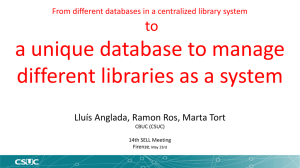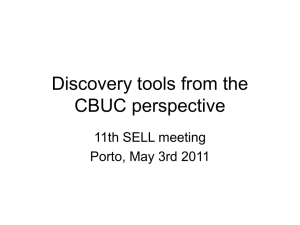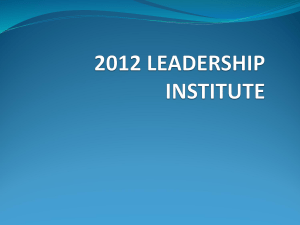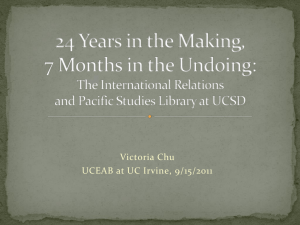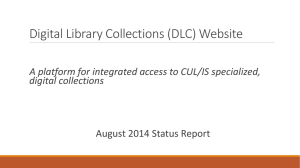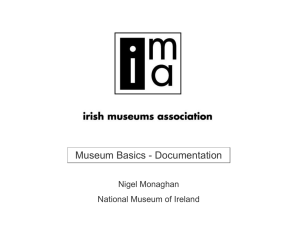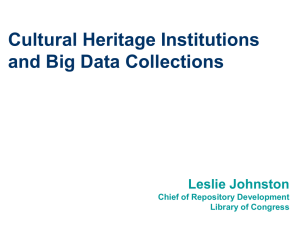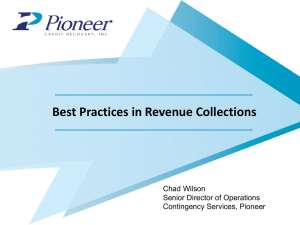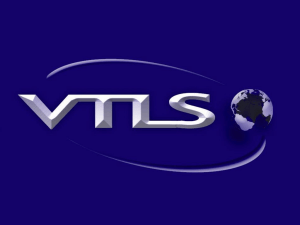Proposta presentació Sistema Compartit al SELL
advertisement
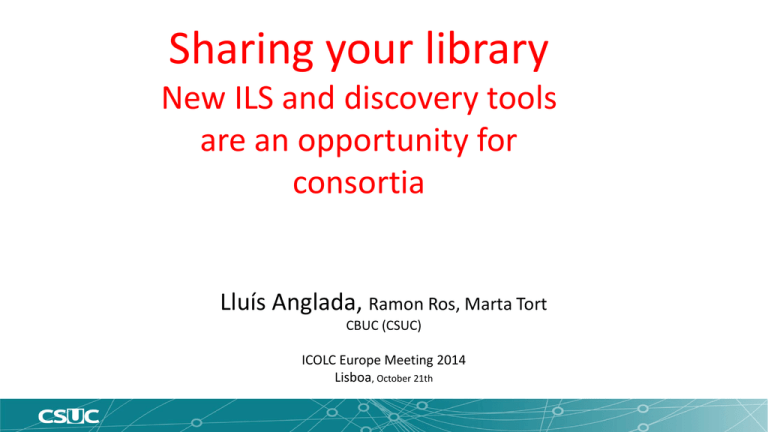
Sharing your library New ILS and discovery tools are an opportunity for consortia Lluís Anglada, Ramon Ros, Marta Tort CBUC (CSUC) ICOLC Europe Meeting 2014 Lisboa, October 21th Sharing your library New ILS and discovery tools are an opportunity for consortia Lluís Anglada, Ramon Ros, Marta Tort CBUC (CSUC) ICOLC Europe Meeting 2014 Lisboa, October 21th Sharing your library cooperation and new software tools are an opportunity to improve library services Lluís Anglada, Ramon Ros, Marta Tort CBUC (CSUC) ICOLC Europe Meeting 2014 Lisboa, October 21th A short preamble • “Cooperation between libraries has always been considered a Good Thing, like belief in God and motherhood. However, belief in God is by no means universal , and a great deal more effort is nowadays spent on trying to avoid motherhood than on trying to achieve it. Similarly, library cooperation is something to which much lip-service is paid but which is practised relatively rarely, and when it is practised is rarely effective”. – Maurice B. Line, "Is Cooperation a Good Thing?." 1979 IATUL Proceedings http://docs.lib.purdue.edu/iatul/1979/papers/1 • When cooperation is effective? – Usefulness: When is able to create useful service (a new one that we could not create alone) – Savings: When it allow us to save money (money that we can redirect to improve services) News ILS and discovery tools are an opportunity for consortia • How old tools has been an opportunity to increase library cooperation – The traditions union catalogues and their evolution – The traditional ILL and their evolution • Are the new tools really new and really tools? • How new tools cold be an opportunity to increase library cooperation – Union catalogues and shared system – Shared collections and maximize discoverability The consortia predecessors: library networks • They where born to share costs (= computer) – OCLC (and ILLINET, MINITEX, NELINET) – PICA – Regional library systems in UK (as Scolcap in Scotland) – Bibsys (Norway) –… • They created – Union catalogues and – ILL services Union catalogues • Good in Usefulness – Bibliographic information improves – More discovery to your collections • Good in indirect savings – Copy cataloging !!! • To catalogue in Catalan university libraries could cost 3.310.281,00 € more without the union catalogue CCUC. • But, also, very complex and costly to create. Traditionally you needed: • A dedicated machine • To create the union DDBB additionally to the local ones • To use the same system CBUC scenario before 2005 Local database: VTLS We used to have this… but eleven times! Local database: VTLS Local database: VTLS Local server Local server Local database: VTLS Local IT staff Local IT staff Local database: VTLS Local server Local database: VTLS Local IT staff Local server Local server Local database: VTLS Local database: VTLS Local server Local IT staff Local database: VTLS Local database: VTLS Local IT staff Local IT staff Local server Local server Local IT staff Local server Local IT staff Local server Local IT staff Local IT staff CBUC scenario after 2005 Local databases: Millennium We centralized local catalogs but also offered new services (Clúster, SFX, Metalib, PUC, etc.) Centralized server Clúster Central CBUC IT staff We save 552.112 € anually, on • IT staff • Hardware purchasing and maintenance • Software licensing SFX and Millennium Centralized server Central CBUC IT staff Centralized server Central CBUC IT staff Interlibrary loan (also called ‘resource sharing’) • Good in Usefulness – Users can get more books – Library offer increases • Good in indirect savings (?) – You have not to buy all that the users ask for • But, also, very complex and costly to create. Traditionally you needed: – Library agreements – Mail delivery – Another software, usually independent from ILS – Library staff (because is a mediated service) PUC, the consortial borrowing (using an old tool) • • • • PUC in Catalan means I can do that It began in late 2011 It is patron initiated It is a free service • PUC allows students, faculty, and staff to easily search and request library materials owned by member libraries • Every member library agrees to follow the same procedures and policies • It allows to make the request directly from the CCUC union catalog interface (no ILL services intermediation) PUC, the consortial borrowing 50,837 45,726 From 2010 to 2013: 37,542 30,436 32,761 67% increase! ILL extend the access to the library collection, and ILL ILL Requests 2010 ILL+ PUC start Requests 2011 PUC PUC Requests 2012 PUC PUC Requests 2013 Requests 2014 (JanSep) consortial borrowing extend the access to the library collection even more! News ILS and discovery tools are an opportunity for consortia • How old tools has been an opportunity to increase library cooperation – The traditions union catalogues and their evolution – The traditional ILL and their evolution • Are the new tools really new and really tools? – From ILS to LSP – From OPAC to DT • How new tools cold be an opportunity to increase library cooperation – Union catalogues and shared system – Shared collections and maximize discoverability Are the new systems really new? From ILS to LSP • Marshall Breeding (Library Systems report 2014) – Form ILS to Library services platforms (LSP) – OCLC Worldshare Management System, ALMA (Ex-Libris), Sierra (Innovative), Spydus 9 (Civica), Kuali OLE, Open Skies (VTLS), Intota (Serials Solutions) • Main features of the Next Generation ILS: – – – – – – They manage the whole library, specially the electronic content They work with different metadata formats at the same time: MARC, DC, DCQ, METS, etc. Cloud based Designed for a high cooperation and reuse Multitenant They are not closed systems, they are platforms where to build apps on top of Multitenancy • Multitenancy (Wikipedia) – software architecture where a single instance of the software runs on a server, serving multiple tenants. – A tenant is a group of users sharing the same view on a software they use. – … multitenant architecture … provide every tenant a dedicated share of the instance... – Multitenancy contrasts with multi-instance architectures where separate software instances operate on behalf of different tenants. • Multitenancy in Twitter – You: @lluisanglada – Your group: following – A topic: #libraries Are the new systems really new? Form OPAC to DT • OPACs appear in the late '70, and they changed the way how to discover library books. But, OPACs has never served 100% of the discovery needs of library users – For current awareness (usually better serve for DDBB) – For special collections (usually catalogued in separate fields) • Discovery Tools (DT) – Federated searches has been the first attempt for a tool that allows to discover between all articles of all the subscribed journals – The first to use this name was AquaBrowser (an improved OPAC) • “Provide a simple, intuitive search interface & Make catalog and local collections more discoverable” – Now they combine DT = mega index & filtering facilities that allow a single search for all the library resources (books, articles, and digital objects in digital repositories) • Summon (2009) Where discovery happens? • ‘Discovery’ includes several functions or processes (*): – Known-item search = one seeks to locate a specific information resource already known through previous use, citation, or otherwise • known-item searches, = accessibility – Current awareness = stay up to date in their field • current awareness, = discoverability – Exploratory search = one seeks as-yet unknown information on some topic (*) Roger C. Schonfeld / Does discovery still happen In the library? : roles and strategies for a shifting reality // Ithaka S + R, 2014 100% library current awareness 80% Percentatge 60% CAT 2014 EUA 2012 40% 20% 0% Una base de dades especialitzada (PubMed, Scopus, Web of Science, etc.) Un motor de cerca a Internet (Bing, Google, Yahoo, etc.) El catàleg de la meva biblioteca Els prestatges de la meva biblioteca (col·leccions de llibres i revistes impreses) 100% library knownitem searches 80% Percentatge 60% CAT 2014 EUA 2012 UK 2012 40% 20% 0% Al catàleg o pàgina web de la biblioteca A una base de dades especialitzada A un motor de cerca a Internet (Bing, (PubMed, Scopus, Web of Science, etc.) Google, Yahoo, etc.) Un altre New needs (*) • The evolving scholarly record: Libraries acquire, organize, and provide stewardship of the scholarly record. Ongoing redefinition of the scholarly record will drive changes in library and publishing practice. – You need resources to create new services • The inside-out collection: The dominant library model has been outside-in, where materials are purchased or licensed from external sources and made available to a local audience. The inside-out model, where institutional materials (digitized special collections, research and learning materials, researcher expertise profiles, etc.) are shared with an external audience requires new ways of thinking. – You need to push your data out • Sourcing and scaling: Collections will be managed at several levels, above the institution as well as within it. Choices about the optimum level (institutional, consortial/group, regional, global) for management are becoming more common, as are decisions about how to source activities (collaborative, buy from third party, etc.). – You need resources from others (*) Dempsey, Lorcan, Constance Malpas, and Brian Lavoie. 2014. "Collection Directions: The Evolution of Library Collections and Collecting" portal: Libraries and the Academy 14,3 (July): 393-423. The key question: Are new tools (LSP & DT) aligned with new needs? • Allow us to save resources? – yes • Allow us to improve the discovery of resources owned by the library? – yes • Improve the role of the library as starting point in a current awareness search? – Not clear (search has moved to the network level) • Makes more visible library resources? – No (not yet) • Allow us to embed library resources in research workflows? – No News ILS and discovery tools are an opportunity for consortia • How old tools has been an opportunity to increase library cooperation – The traditions union catalogues and their evolution – The traditional ILL and their evolution • Are the new tools really new and really tools? • How new tools cold be an opportunity to increase library cooperation – Union catalogues – Shared system – Shared collections – Maximize discoverability DT are a very cheap way to create union cataloguess BUCLE union catalogue (OCLC World Cat) Montana Academic Libraries (Ex-Librs Primo) CBUC scenario after 2005 Local databases: Millennium We centralized local catalogs but also offered new services (Clúster, SFX, Metalib, PUC, etc.) Centralized server Central CBUC IT staff Clúster We saved on: • IT staff • Hardware purchasing and maintenance • Software licensing SFX and Millennium Centralized server Central CBUC IT staff Centralized server Central CBUC IT staff CBUC future shared system Shared database on a Next Generation ILS SaaS based Central CBUC IT staff We do not expect to save much on: • IT staff • Hardware purchasing and maintenance • Software licensing Our goal: Increase productivity (= savings) a lot based on: • Simplifying duplicate tasks • New & improved workflows Shared collection • Shared collections in digital world • Big deals for e- journals • Big deals for data bases • Big deals also for e- books ? • Shared collections in print world • Union catalogue • Consortial borrowing deals • Mail service • (storage facility) Shared collection = increase accessibility 27/17 Shared (print) collection • Jacob Nadal, ReCAP (Columbia U, NYPL; Princeton U): – “Our next major initiative is to turn ReCAP from a shared operation into a shared collection, giving each partner full access to more than 3 million additional items and providing a foundation for collaboration on major collecting efforts in the years ahead.” • Catherine Murray-Rust, Georgia Tech’s vice provost for learning excellence and dean of libraries – The collaboration between Georgia Tech and Emory University in Atlanta “aims to develop a shared collection between our two institutions, both retrospectively and prospectively,” Shared or collective collections OCLC Collections Grid L Dempsey Outside, in Then In many collections Library as broker Maximise efficiency Licensed Commodity Purchased A Low Stewardship High Stewardship Distinctive Library as provider Maximise discoverability Inside, out In few collections Now Inside, out = maximize discoverability = • In the transition from print world to digital world, the digital divide affects not only people, also documents – – – – some documents are rare and fragile a lot have not commercially interest quite a lot are the memory of very few … • Actions – first, localize and conserve – second, digitalize – third, expose (= maximize discoverability) • And to do this, cooperation is useful and save resources • Maurice B. Line tells us that cooperation is sometimes like second marriages, which represent "the triumph of hope over experience”, and that “cooperation should not be undertaken unless it is likely to produce better results than would be achieved by other means” (3). • (3) Maurice B. Line “Co-operation: the triumph of hope over experience?”, • Interlending & document supply, 25 (1997) issue 2: 64-72. A short afterword • Maurice B. Line tells us that cooperation is sometimes like second marriages, which represent "the triumph of hope over experience”, • and that “cooperation should not be undertaken unless it is likely to produce better results than would be achieved by other means” – Maurice B. Line “Co-operation: the triumph of hope over experience?”, Interlending & document supply, 25 (1997) issue 2: 64-72 • There are two measures for the effectiveness of the cooperation: – if it is able to create useful service, and – if it is able to save money Many thanks langlada@gmail.com @lluisanglada
